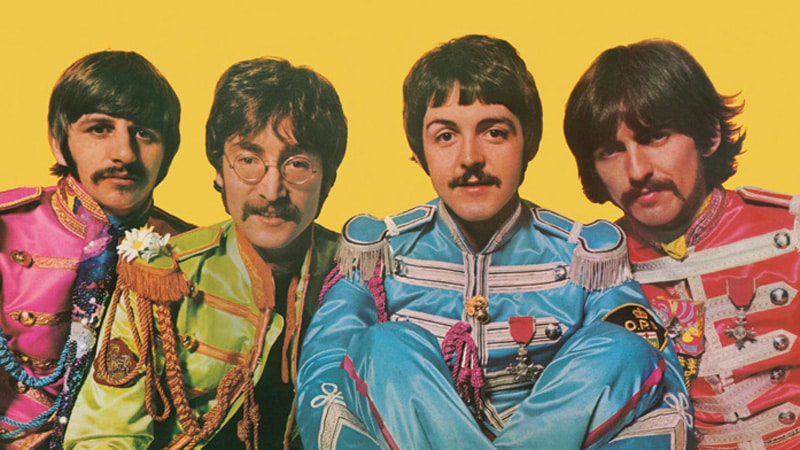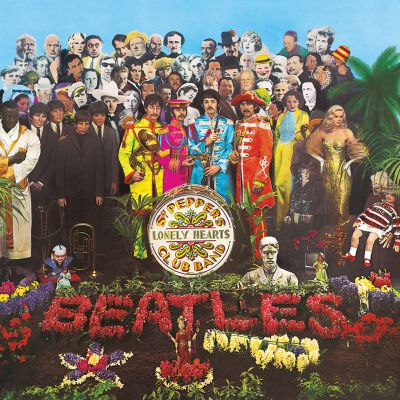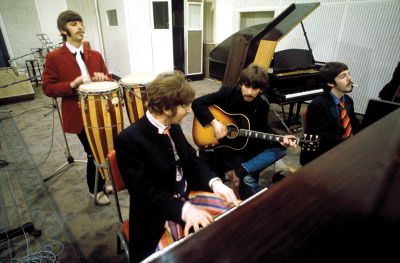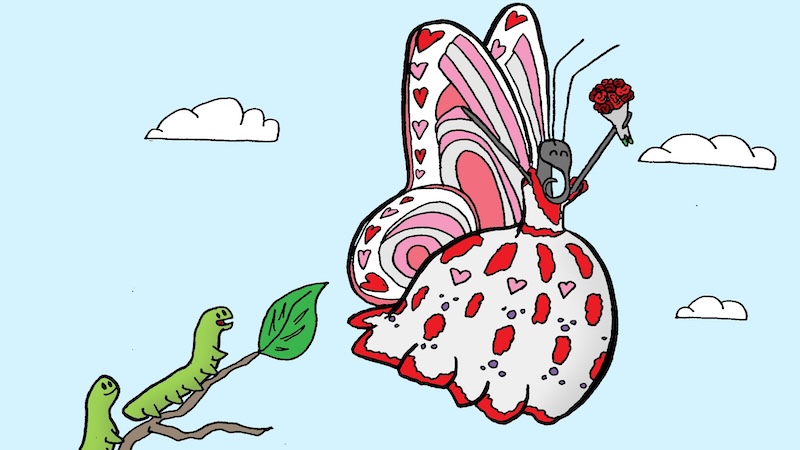Looking Back on Sgt. Pepper's Lonely Hearts Club Band
50 Years Ago

For the Beatles, the Sgt. Pepper’s Lonely Hearts Club Band album, released on June 1, 1967, may have really begun on Aug. 29, 1966, at Candlestick Park in San Francisco. It was on that date that the group ceased touring and effectively ended its time as a live band. As the Beatles left the concert, George Harrison may have quipped that the Beatles were over, but, in fact, the event would mark the prelude to the group’s greatest collective work, which still stands for many critics and music fans as the most important album ever made.
 THE PATH TO THE CLUB
THE PATH TO THE CLUB
The Beatles had certainly come a long way from the first flush of Beatlemania that marked their American invasion in 1964 as pop chart hit-makers. Even as early as 1965 on the Help album, the soundtrack to the group’s second film, the title track and “Yesterday” showed the group writing more sophisticated songs and experimenting musically.
It was the group’s second 1965 album, though, that truly changed their direction. Rubber Soul was a textured, varied, occasionally brooding and unsettling collection of songs that revealed a depth and complexity of compositions and new sounds created in the recording studio that still resonate with musicians today. For some, it is actually considered the group’s best and most enduring work. It was also a clear break from the kinds of sounds the group had performed in the past and was no doubt strongly influenced by the songwriting of Bob Dylan.
While Rubber Soul signified a shift in the group’s sound, Revolver in 1966 went in a completely different direction. It was the group’s most overtly psychedelic work, boasting brash, pungent, backward guitar loops, strong Indian music influences, odd time signatures, evocative songs of yellow submarines and mysterious doctors, dreamy imagery and the album’s Eastern philosophical coda, “Tomorrow Never Knows.” That song set the stage for the next two singles, which would serve as the appetizer for Sgt. Pepper.
The two singles in question were actually released as a double A-sided 45 rpm single, comprised of “Penny Lane” and “Strawberry Fields Forever,” two tracks that would not be out of place on Sgt. Pepper. They reflected the strengths of their composers, with “Penny Lane” showing off Paul McCartney’s pure pop instincts and Lennon’s “Strawberry Fields Forever,” a trippy, impressionistic, psychedelic tone-poem, forming the musical template for Sgt. Pepper.
AN ALBUM FOR ITS TIME
It is no surprise that Sgt. Pepper was released on June 1, 1967. That was the Summer of Love and, for many, Sgt. Pepper was the soundtrack. The concept of the album was Paul McCartney’s. The idea was to create a band that would be the alter ego of the Beatles and once and for all allow the group to escape the mop-top image of a pop band. One of the most overlooked aspects of the music on the album was its use of pre-rock musical styles as the basis for much of the music. The almost classical-sounding “She’s Leaving Home,” with its waltz feel; the old-timey jauntiness of “When I’m Sixty-Four”; and “For the Benefit of Mr. Kite,” with its fairground calliope sound – all remain fresh today because they weren’t encased in psychedelic amber.
The group’s pop, R&B and rock instincts were on full display on the title track, “Lovely Rita,” “Getting Better” and “Good Morning Good Morning.” “Fixing A Hole” combined m any styles but lyrically joined the album’s more overtly psychedelic tracks, which defined its singular vision. Such tracks include “With A Little Help from My Friends,” which could be construed as the anthem of the age; “Within You and Without You,” George Harrison’s follow-up to “Tomorrow Never Knows”; and “Lucy in the Sky with Diamonds” and “A Day in the Life,” from John Lennon, compositions that faithfully follow the psychedelic imagery of “Strawberry Fields Forever.”
any styles but lyrically joined the album’s more overtly psychedelic tracks, which defined its singular vision. Such tracks include “With A Little Help from My Friends,” which could be construed as the anthem of the age; “Within You and Without You,” George Harrison’s follow-up to “Tomorrow Never Knows”; and “Lucy in the Sky with Diamonds” and “A Day in the Life,” from John Lennon, compositions that faithfully follow the psychedelic imagery of “Strawberry Fields Forever.”
It wasn’t just the music, songs and studio wizardry, aided by producer George Martin and engineer Geoff Emerick, that made the album such an important moment in popular culture, but also the album’s iconic artwork, staged and photographed by Michael Cooper, who would also create and photograph the Rolling Stones’ 1967 album cover of Their Satanic Majesties Request. Featuring a collage of the Beatles’ influences and the group in its Lonely Hearts Club gear – juxtaposed with wax figures of their earlier mop-top selves observing, among other delights, the album cover – is easily the most recognizable and emulated in rock history.
To mark the anniversary, Apple Records is reissuing the album in late May in various formats. A six-disc edition will include 33 previously unreleased recordings from the sessions, a Blu-ray and a DVD. The set will also include documentary footage, various mixes and a 144-page booklet.
Steve Matteo is the author of Let It Be (33 1/3-Bloomsbury) and Dylan (Sterling). The Beatles in Context: Documentary, Rockumentary: Let It Be and the Rooftop Concert will be published by Cambridge University Press. He has written for such publications as The New York Times, The Los Angeles Times, New York magazine, Time Out New York, Rolling Stone, Interview, Elle and Salon.


